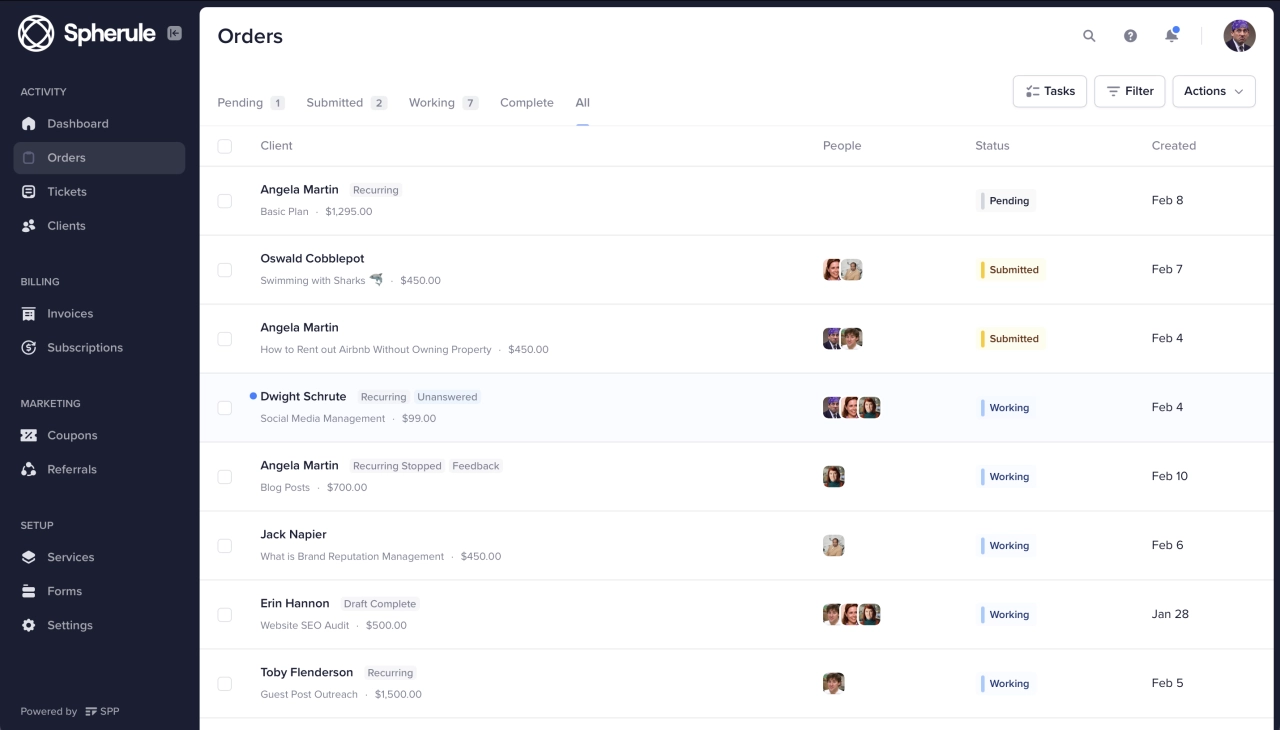Service Standardization ROI Calculator for productized Agencies
Determine whether investing in systems, templates, and processes is worth the cost by calculating the ROI of standardization investments over time.
Frequently Asked Questions
- What does this Service Standardization ROI Calculator do?
-
This calculator helps productized agencies determine if investing in service standardization (creating systems, templates, processes, and documentation) will be financially worthwhile. It answers the question: "How quickly will we recover our investment in standardization, and what's the long-term ROI?"
The calculator considers both direct efficiency benefits (time savings) and quality improvements (reduced revisions), providing a comprehensive view of how standardization impacts your agency's finances over time.
- What inputs should I provide for accurate results?
-
For the most accurate ROI calculation, gather these data points:
- Current delivery time: The average time (in hours) it currently takes to complete one deliverable
- Estimated time after standardization: Your reasonable projection for delivery time after implementing systems and processes
- Cost of standardization: The one-time investment for creating documentation, templates, training, etc.
- Monthly deliverable volume: How many units your team typically delivers each month
- Hourly rate: The value of your team's time (either your cost rate or billable rate)
- Implementation period: Realistic timeline (in months) until you achieve full efficiency
- Current revision rate: The percentage of deliverables currently requiring revisions
- Hours per revision: Average time spent on each revision
- Expected revision rate: Anticipated revision percentage after standardization
The more accurate these inputs are, the more reliable your ROI projection will be. When in doubt, use conservative estimates to avoid overly optimistic projections.
- How does the calculator account for the gradual implementation of standardization?
-
Most standardization projects don't yield results immediately. The calculator models this reality using implementation curves:
- Linear (steady progress): Benefits increase at a constant rate throughout the implementation period
- S-curve (slow start, rapid middle, plateau): Initial slow adoption, followed by accelerated implementation, then diminishing returns as you approach full efficiency
- Fast-start (quick gains, then plateau): Rapid initial improvements that taper off as you approach full implementation
The calculator uses your selected curve to model month-by-month efficiency gains, calculating partial benefits during the implementation phase rather than assuming full benefits from day one.
The S-curve option is the default and typically most realistic for standardization initiatives, as it accounts for the learning curve and organizational change dynamics.
- How does the calculator measure quality impact?
-
The calculator goes beyond simple time savings to account for quality improvements through reduced revisions, which are significant profit killers for agencies. The quality impact is calculated through:
- Reduction in revision rate: The percentage difference between your current revision rate and expected rate after standardization
- Monthly revisions avoided: Your monthly volume multiplied by the revision rate reduction
- Time saved from fewer revisions: Revisions avoided multiplied by your average hours per revision
- Value of revision reduction: Time saved multiplied by your hourly rate
- Client satisfaction value: The business value of improved client satisfaction from fewer revisions (in terms of retention, referrals, etc.)
This approach recognizes that standardization not only makes work faster but also more consistent and higher quality, which has substantial financial benefits beyond time savings.
- What does the "Client Satisfaction Value per Avoided Revision" mean?
-
This metric represents the estimated business value gained from increased client satisfaction when a revision is avoided. It includes:
- Improved client retention: The value of extending client relationships through higher satisfaction
- Enhanced reputation: Value from word-of-mouth referrals and testimonials
- Reduced client management time: Less time spent managing client expectations and frustrations
- Potential for upsells: Increased opportunities for expanding client services
While this value is somewhat subjective, research shows that revision-free deliverables significantly impact client satisfaction and long-term business value. The default value of $250 is conservative for most agencies, as the lifetime value of improved client relationships often exceeds this amount per avoided revision.
- How should I interpret the results?
-
The calculator provides several key metrics to help you understand the ROI:
- Payback period: The time required to recover your initial investment (shorter is better)
- Annual ROI: First-year return on investment as a percentage (higher is better)
- Monthly and annual impact: The ongoing monthly and yearly financial benefits after full implementation
- Breakeven point: The specific month when cumulative benefits exceed your investment
Generally, standardization investments with payback periods under:
- 30 days are excellent investments (immediately pursue)
- 90 days are strong investments (high priority)
- 180 days are good investments (medium priority)
- Over 180 days may still be worthwhile, but should be evaluated against other opportunities
The detailed implementation table shows month-by-month progress towards breakeven, helping you track whether you're on target during actual implementation.
- What types of standardization investments should I consider?
-
The "Cost of Standardization" can include a variety of investments that create systems and repeatable processes:
- Documentation: Process documentation, workflow guides, SOPs, and client onboarding materials
- Templates: Design templates, content frameworks, code libraries, and QA checklists
- Software tools: Project management systems , workflow automation tools, and client portals
- Training: Internal team training, certification programs, and client education materials
- Expert consulting: Outside expertise to help develop standardization systems
- Internal resources: Team members' time dedicated to standardization (opportunity cost)
For most agencies, the highest-impact standardization investments typically include client intake processes, core delivery workflows, QA systems, and client communication templates.
- How can I make more accurate time-saving estimations?
-
When estimating time savings from standardization, consider these approaches:
- Pilot test: Implement standardization for a small subset of deliverables and measure the actual time savings
- Process analysis: Break down your current process into steps, identify which steps will be streamlined, and estimate time reduction for each
- Historical data: Compare delivery times between ad-hoc projects and those where some standardization was already applied
- Industry benchmarks: Research similar standardization efforts in your industry (typically 20-40% time savings)
- Expert input: Consult with operations specialists or efficiency consultants familiar with your service type
When in doubt, use conservative estimates (e.g., 20-25% time reduction) to avoid overestimating benefits. Remember that time savings often increase beyond initial projections as teams become more familiar with standardized processes.
- Should I use our cost rate or billable rate for the hourly rate input?
-
The choice between cost rate and billable rate depends on your business model and perspective:
-
Cost rate:
Use your team's actual cost (salary +
benefits + overhead) if:
- You have fixed-price packages rather than hourly billing
- You want a conservative estimate of time value
- You're focused on cost reduction rather than revenue opportunities
-
Billable rate:
Use your standard billing rate if:
- You bill clients hourly and can directly convert saved time to new billable work
- You want to see the revenue potential of freed-up capacity
- You can realistically sell the additional hours gained
Many agencies use a blended approach, using something between their cost rate and full billable rate to account for the fact that not all saved time will be converted to revenue but is still more valuable than just the cost basis.
-
Cost rate:
Use your team's actual cost (salary +
benefits + overhead) if:
- What's a realistic implementation period for standardization efforts?
-
Implementation periods vary based on the scope and complexity of your standardization initiative:
-
Small standardization projects
(single service or process):
- Development: 2-4 weeks
- Implementation: 1-2 months
-
Medium standardization projects
(multiple services or comprehensive
templates):
- Development: 1-2 months
- Implementation: 2-4 months
-
Large standardization projects
(agency-wide systems):
- Development: 2-3 months
- Implementation: 3-6 months
Consider factors like team adoption rates, training requirements, and whether you're standardizing existing processes or creating entirely new ones. Cultural change and team habits typically take longer to adjust than the technical implementation of tools or templates.
-
Small standardization projects
(single service or process):
- How does standardization impact team satisfaction and retention?
-
While the calculator focuses on financial ROI, standardization also significantly impacts team experience:
- Reduced stress: Clear processes and systems reduce uncertainty and last-minute scrambling
- Faster onboarding: New team members become productive more quickly with documented processes
- Greater satisfaction: Reduced revisions means less rework and frustration
- Improved work-life balance: Efficiency gains often translate to fewer nights and weekends
- Career growth: Team members can focus on higher-value work rather than repetitive tasks
These benefits contribute to improved team retention and reduced hiring costs, which aren't directly calculated in the ROI but represent significant additional value for most agencies. Research indicates that systematized agencies typically see 15-30% higher team retention rates.
- What are common pitfalls when implementing standardization?
-
To achieve the ROI projected by the calculator, avoid these common standardization pitfalls:
- Over-documentation: Creating excessively detailed processes that team members won't read or follow
- Tool overload: Implementing too many software tools without proper integration
- Neglecting team input: Failing to involve practitioners who will use the standardized processes
- One-time effort: Treating standardization as a project rather than an ongoing practice
- Rigidity: Creating inflexible systems that don't allow for exceptions or customization
- Poor adoption management: Not providing adequate training or incentives for team adoption
The most successful standardization initiatives focus on the 20% of processes that drive 80% of results, involve team members in the design process, and include regular review and refinement cycles.
- What standardization investments typically have the highest ROI?
-
Based on agency benchmarks, these standardization investments often deliver the highest ROI:
- Client onboarding systems: Standardized intake forms, welcome packets, and kickoff processes
- QA checklists: Comprehensive review processes to catch issues before client delivery
- Project templates: Pre-built frameworks for common deliverables (reducing "blank page" syndrome)
- Client communication templates: Standard responses for common situations and update frameworks
- SOP documentation: Step-by-step processes for frequently repeated tasks
The highest ROI standardization efforts typically focus on high-frequency, repetitive processes with clear inputs and outputs. One-off or highly creative processes usually benefit less from standardization.
- Will standardization make our work feel too "cookie-cutter"?
-
This is a common concern, but well-designed standardization actually enhances creativity by:
- Freeing creative energy: Standardizing routine aspects allows more focus on creative elements
- Creating guardrails, not straitjackets: Good systems provide structure while allowing flexibility
- Standardizing process, not output: The process can be consistent while deliverables remain unique
- Improving collaboration: Shared frameworks enable better team creativity
The most effective approach is often "templatizing the common 80%" while leaving space for customization in the critical 20% that distinguishes each client's needs. This balances efficiency with personalization.
Many highly creative agencies report that standardization paradoxically increased the perceived uniqueness of their work by ensuring consistent quality and enabling their team to focus creative energy where it matters most.
- How can I track actual ROI after implementing standardization?
-
To measure your actual ROI and compare it to the calculator's projections:
- Establish baselines: Before implementation, document current delivery times, revision rates, and team capacity
-
Track key metrics:
Monitor these metrics throughout
implementation:
- Actual time per deliverable
- Revision requests per project
- Team utilization rates
- Client satisfaction scores
- Calculate actual savings: Compare pre- and post-standardization metrics monthly
- Document qualitative benefits: Collect team and client feedback on process improvements
- Reassess regularly: Update your ROI calculation quarterly with actual data
Most agencies find that standardization ROI compounds over time as systems are refined and team proficiency increases. The long-term benefits often exceed the calculator's projections, especially when considering difficult-to-quantify benefits like improved team collaboration and knowledge retention.

You're in good company. We've helped agencies like yours sell $500M+ in services.


